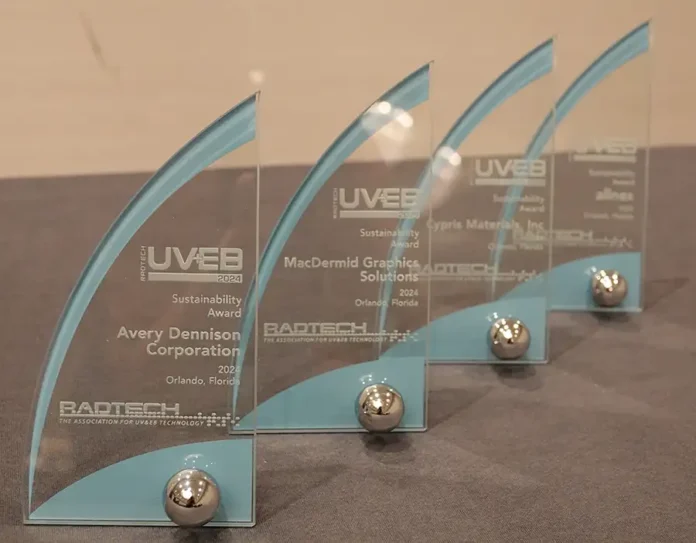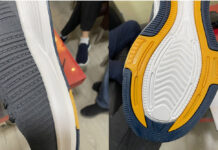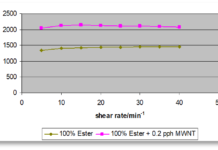At the 2024 RadTech UV+EB Technology & Conference event, held in May in Orlando, Florida, the 2024 Sustainability Award honorees were announced. These companies’ pioneering use of ultraviolet and electron beam (UV/EB) technologies leads the way for sustainable and responsible manufacturing practices. This year’s honorees have demonstrated various benefits, including energy savings, CO2 reductions, minimized water usage and a significant decrease in VOC and hazardous air pollutant emissions. Moreover, they’ve streamlined supply chains, reduced transportation costs and slashed waste through recyclability and material substitution.
The awards were presented by Todd Fayne, PepsiCo, who has helped lead the association’s efforts on the RadTech Sustainability Committee. UV/EB technology is known for many environmental positives, offering users a great opportunity to transform their systems to more efficient and cleaner processes. RadTech’s Sustainability Committee aims to better promote the environmental benefits of UV/EB and explore how the industry can address increasing environmental concerns.
Avery Dennison Corporation
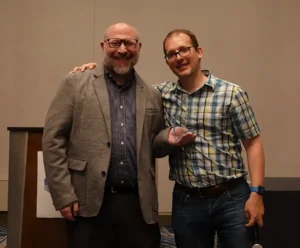
Avery Dennison has developed innovative and more sustainable UV-cured adhesives (UV WarmMelt), replacing solvent-based adhesives without compromising performance. The main advantage of UV WarmMelt adhesive technology over traditional UV HotMelt and solvent-based adhesives is its extremely low levels of VOCs and odors. Since the adhesives are made without solvents or other potentially hazardous process aids, they are a particularly good fit for applications in strict regulatory environments, such as medical, automotive, or home and personal care applications. The use of UV technology will enable Avery Dennison to achieve its 2030 GHG reduction commitments. This includes reducing Scope 1 emissions by 70% by 2030, compared to a 2015 baseline, and reducing Scope 3 emissions by 30% by 2030, compared to a 2018 baseline. The introduction of the UV WarmMelt adhesive RR3030 for Avery Dennison’s wet wipe reclosure portfolio is a clear and important step forward to achieving the company’s 2030 goals as it replaces existing solvent acrylic adhesive solutions without any compromise in performance. An initial life cycle analysis reports a 25% CO2 reduction in comparison with a solvent adhesive alternative, reducing the water needed to produce the material by 50%.
MacDermid Graphics Solutions
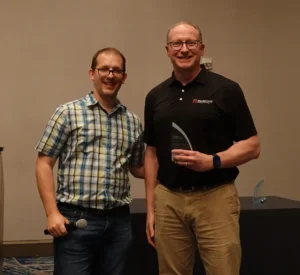
MacDermid Graphics Solutions produces photopolymer printing plate precursors for the flexographic printing industry, which subsequently are UV cured and processed by its customers. A process has been developed to collect and repurpose used printing plates into various end products, which can include a wide variety of foam-based applications, such as construction, matting applications (carpet, anti-fatigue applications), ceiling panels and many more. It is estimated that 15 million lbs of flexo plates or more are used in the Americas annually. They are currently being utilized in waste to energy processes – but some to landfill. MacDermid now offers an alternative to repurpose such waste into new products. Previous attempts have struggled with handling of used plates due to the combined composition of the photopolymer material, an adhered PET backing and dried ink. This process utilizes the combination of materials without pre-separation techniques and results in either circular (within the flexo industry) or ancillary (outside of the flexo industry) product applications, with further outlets under development.
Cypris Materials, Inc.
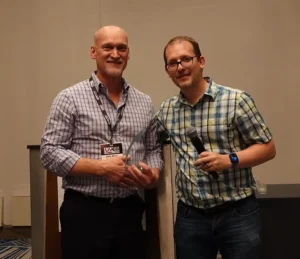
Cypris’ patented copolymer technology eliminates the need for the most polluting components of colored coatings: pigments and dyes. CYPRIS™ structural color isn’t just superior in environmental and social impact, it also eliminates complex manufacturing processes and supply chain logistics while catching the consumer’s eye with never-before-seen color effects. This differentiated approach yields coatings with applications far beyond the reach of traditional pigments, including ultraviolet and near-infrared heat reflective coatings, opening new market opportunities. Cypris prioritized UV-curable coatings as its first commercial application to offer customers the lowest possible cradle-to-grave carbon footprint option. One hundred percent solids UV coatings already offer a lower carbon footprint option to traditional water, solvent and powder coating options. However, to further reduce the environmental impact of colored coatings, one needs to consider the pigments. Recent life cycle assessment (LCA) analysis demonstrates that CYPRIS structural color copolymer has one-fifth the carbon emissions of organic pigments. UV/EB-curable coating technology, in conjunction with CYPRIS copolymer, offers the lowest carbon footprint coating option. CYPRIS structural color copolymers are 50% plant based, making them more sustainable than petroleum-based pigments and dyes.
allnex
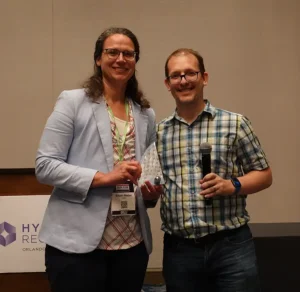
allnex collaborated to develop a customized UV-curable resin for 3D-printed homes with Mighty Buildings, an innovative California company that uses 3D-printing technology to manufacture sustainable and climate-resilient high-quality homes. In this sustainability-focused partnership, allnex provides the materials Mighty Buildings uses to print the predesigned parts that then are assembled in progressive kit-of-parts construction to build homes onsite. The panels are critical elements, helping the company in its drive toward more sustainable building solutions, featuring 80% automated production, 99% less construction waste and 60% recycled printing materials. The homes can be built in half the time of conventional homes by combining materials science with robotics and automation, as it is a goal of Mighty Buildings to make carbon-neutral housing a reality for everyone. Since the walls are built layer-by-layer from the ground up, they must be cured more or less instantly to ensure proper workflow, as enabled by UV-cured resins. By combining just the right monomer and oligomer, allnex says it customizes the formulation for the company’s special technology, which cures each extruded layer on the spot using a UV source attached to the nozzle.
Allied UV
Allied UV’s process solutions allow North American manufacturers to replace solvent-based and water-based coating solutions with 100% solids UV solutions, with no VOCs or HAPs. These coatings provide corrosion protection for mechanical tubing, safety sprinkler pipe, oil country tubular goods (OCTG) line pipe and many other metal or substrates. In one example, Allied UV materials converted a water-based coating (with co-solvents – so it was flammable) to UV coatings. The usage of water-based coating included 2.04 lbs VOC per gallon, @33% solids, 115,151 gallons per year = Total VOC’s of 234,908 lbs per year. Converting to UV coating resulted in no VOCs or HAPs, @100% solids, so needing just 38,000 gallons per year = Total VOC’s of 0 lbs per year. This user reduced VOCs by 234,908 lbs per year (for past four years) – a nearly one-million-pound reduction.
In addition, UV LEDs can help NA manufacturers reduce their energy costs by up to 65% by eliminating ovens/IR heating systems. Additional benefits include a much smaller footprint, faster production speeds, greater efficiency, lowered transportation/handling costs and no mess downstream. Allied also has developed ROI and VOC reduction calculators, which can be found at https://www.alliedphotochemical.com/roi-calculators/.



